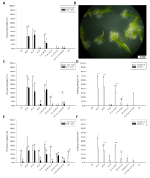Dendrobium Nobile Lindley has ornamental value and is a kind of Chinese medicinal material with a wide range of uses. The natural growth of its wild populations is relatively slow, coupled with the destruction of habitat and human over-collection, resulting in the species' wild resource in an endangered state. In order to protect the species resources of Dendrobium Nobile, researchers from the Orchid Plant Diversity and Conservation Group of the Garden and Horticulture Department of Xishuangbanna Tropical Botanical Garden, Chinese Academy of Sciences carried out symbiotic germination research on its seeds.

The seeds of Dendrobium Nobile are small in size. Under natural conditions in the wild, specific fungal groups are required to infect to initiate germination and complete the subsequent germination process. After the seeds germinate and form protocorms, they gradually begin to photosynthesize and survive in autotrophic or mixed nutrition (autotrophic and fungal heterotrophic). In the previous stages, seed development relied on symbiotic fungi to provide nutrients. However, when seeds are colonized by fungi to initiate germination and protocorm development to form seedlings, the symbiosis process of the two is not clear, such as, how many fungi participate in the process; what are their respective ecological functions; is it possible to obtain cultivable strains for seedling breeding and species return protection? The answers to the above questions can provide a scientific basis for understanding the natural germination process of Dendrobium Nobile seeds.
Researchers obtained the protocorm of Dendrobium Nobile through in situ symbiotic germination technology, and isolated 5 typical orchid symbiotic fungi, including 4 strains of Serendipitaceae and 1 strain of Tulasnellaceae. Among them, the strains of JC-01 and JC-03 can promote seed germination to form seedlings, and the germination efficiency is significantly higher than the promotion effect of other strains; the symbiotic germination of Dendrobium Nobile seeds has relatively low specificity of fungal performance. In addition, through the symbiosis germination experiment of the combined culture of different strains, it was found that the strains (JC-01 and JC-03) that could significantly promote seed germination by co-cultivation did not show a synergistic effect on seed germination, and even had a slightly lower rate of promoting seedlings than a single strain. Strain JC-05 or any combination of strain JC-05 of the promotion of seed germination efficiency is weakened, the formation of seedlings is also less. The study revealed that the initiated germination of golden hairpin seeds and the formation of seedlings through protocorm development are a dynamic process. Although the strains are all typical orchid mycorrhizal fungi, their functions are different; different fungi may perform different ecological functions in different conditions and different developmental stages of plants. In addition, the researchers used the strains JC-01 and JC-03 to carry out direct seeding experiments in the field, the results showed that the strain JC-01 promoted the germination of Dendrobium Nobile seeds more efficiently and in a shorter time. The acquisition of this strain is conducive to seedling breeding and species return protection of Dendrobium Nobile.
Reference
Shi-Cheng Shao, Yan Luo, and Hans Jacquemyn. Co-cultures of mycorrhizal fungi do not increase germination and seedling development in the epiphytic orchid Dendrobium nobile. Front Plant Sci. 2020; 11: 571426. doi: 10.3389/fpls.2020.571426